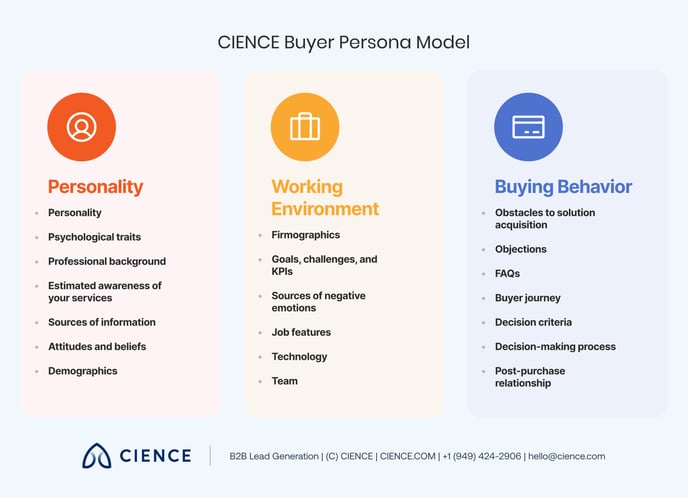Buyer Persona and Ideal Customer Profile: Our New Guide for the Sales Model
Though sometimes used interchangeably, buyer persona (BP) and ideal customer profile (ICP) are distinct terms that represent different ideas. For your sales and marketing efforts to succeed, you need both. In this blog post, we’ll study the ideal customer profile and buyer persona in detail—the peanut butter and jelly of your sales process. We’ll also determine the differences between them and provide clear guidelines on how to create them.
But first, let’s start with an illuminating fairy tale!
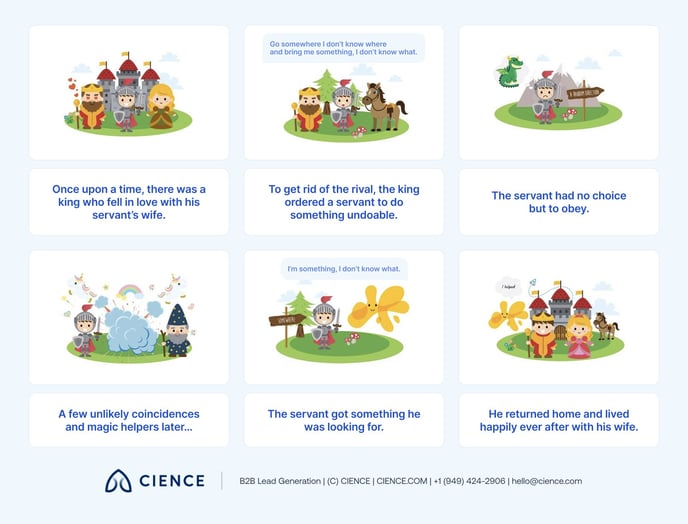
Did you spot our logo in the comics? Have another look!
The king’s order is a perfect example of ineffective management: When applied to lead generation and selling, it can cost millions to companies that dare to use it.
The guy in our tale succeeded; however, despite being highly motivated and almost unattainably high on an ambiguity tolerance scale, his victory was due to magic and luck. After all, fairytales should all end well.
In real life, prospecting is hard, even with a clear roadmap. If you don’t provide clear guidelines to your salespeople on what companies you hope to win and who you should approach to land them, you most likely won’t succeed.
So what organizations does your business need to seek? And who and how should your salespeople reach out to them? What information will your potential customers want to obtain from you?
Creating a buyer persona and ideal customer profile will help you answer the questions above. Follow along in our comprehensive journey to find out why the ICP and BP are both essential for your business.
Ideal Customer Profile and Buyer Persona: What’s the Difference?
So, why does your company need both the ideal customer profile and buyer persona? Aren’t they the same? Not exactly.
The confusion you might experience when coming across the ideal customer profile and buyer persona is understandable: Both terms describe your buyers; however, the very essence and purposes of BP and ICP are different.
The ideal customer profile explains what companies and titles to target. The buyer persona describes how.
The ICP is a filter for your lead generation activities. You’ll need it at the very beginning of your sales funnel. The BP is used to understand your customers, create a customized environment for communication, and tailor your messaging. It’s used at all stages of your marketing funnel.
What they have in common is a profound understanding of who your customers are and who they aren’t. Furthermore, both the ICP and BP are derived from the knowledge of the market, your services, and the problems you solve.
So, make sure that your sales and marketing teams have invested enough time and resources to create these two documents.
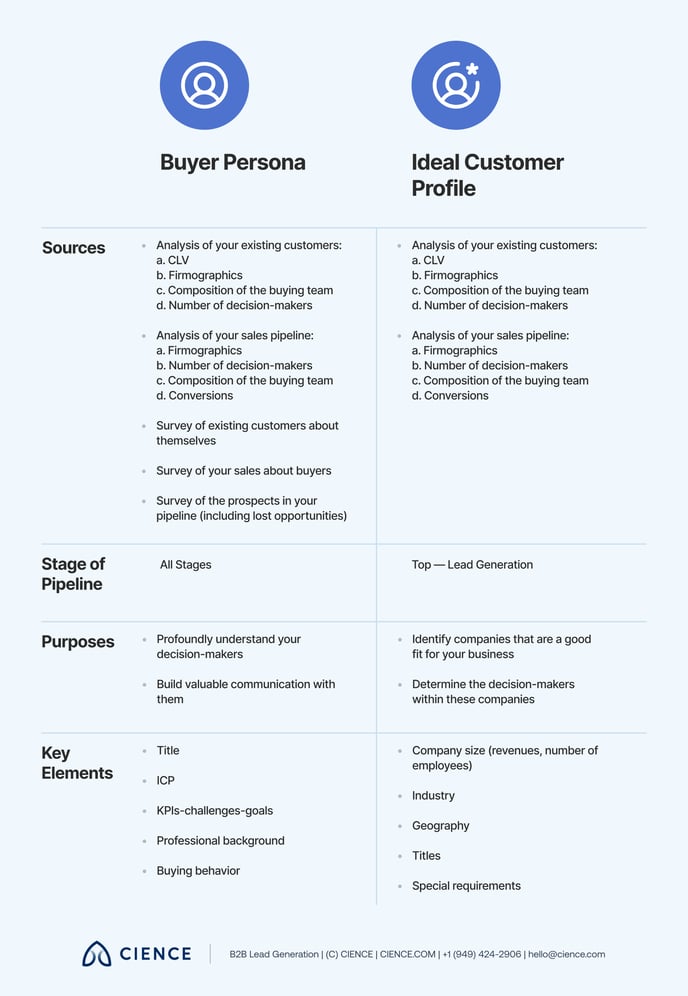
But don’t think of your buyer persona and ideal customer profile as permanent, unchangeable components: As mayour business gains new clients, launches new products, or pursues new titles, you’ll discover plenty of nuances that will change your BP and ICP.
You may realize that some of your clients are too expensive to win or may not be good fits. Don’t hesitate to shift your lead generation efforts elsewhere and update your BPs and ICPs as well.
What Is an Ideal Customer Profile?
An ideal customer profile is a detailed description of a company that is most likely to become your client, along with the titles of its decision-makers that your sales team should target. In other words, it provides guidelines on how to find a perfect lead.
As a lead generation company, we deal with numerous ideal customer profiles daily. In fact, without an ICP, we can’t do our job—search for reliable contact data, conduct outreach, and set appointments. And neither can any sales development team.
At CIENCE, we ask our clients to fill in a standard questionnaire. We later discuss it in great detail and form an ideal customer profile on its basis. Afterward, we give the final ICP to a researcher who will look for leads that fit the requirements.
Based on the ICP, we create a mastersheet for contacts. Each lead has seventeen data columns on average (company name, industry, name, title, location, telephone number, etc.). The mastersheet is then given to an SDR, and the outreach begins.
What are the key elements of an ideal customer profile?
The ideal customer profile consists of two essential parts: The first one describes an organization with a particular problem your company can solve. The second examines specific titles in this company that can be the decision-makers in the buying process.
You can create several ICPs to conduct various campaigns. To create a comprehensive ICP, you’ll need these elements:
1. Company
This part of ICP defines what type of companies you target:
- Industry: Note that one industry can have multiple names. And one company doesn’t have to operate in just one industry. For example, if you want to target software developers, you can include such industries as IT, Internet, software, and business services. If the industry of your potential client is a vital factor for the outreach, make sure you provide a comprehensive description of it.
Tip: If you need help identifying the correct industry name, use industry codes, such as SIC (Standard Industrial Classification) code or NAICS (North American Industry Classification System). - Revenue: Revenues are the easiest way to determine both the total and relative sizing of a business.
- Number of employees: The revenue and number of employees can sometimes fall under the category of “size” at various listings of companies. It can be confusing; however, it’s a regular practice in the United States.
For example, the Small Business Administration determines size by three criteria (affiliates, employees, and annual receipts). The North American Industry Classification System also has three parameters: yearly sales, employees on-site, and total head count. - Region: You can be very specific here. We conducted several research campaigns for our clients that were precisely geo-targeted (certain cities in certain counties).
If you target the whole U.S., begin your contact data generation from the East Coast and move westward. In this case, your sales team will have more convenient time slots for outreach, setting, and conducting appointments by territory.
2. Person
This part will include the title(s) of decision-makers or decision-influencers you plan to target.
3. Special requirements (optional)
Use criteria that will narrow your search and customize your outreach:
- Type of institution (e.g., out of all health organizations, you need only hospitals)
- Technology or software your leads use (a.k.a. tech stack)
- Participants of a particular event
- Size of the building (for large factories)
- Number of affiliates
- Years in business or a certain role
- Product/service the lead offers
- Certain events in the company (e.g., mergers and acquisitions, venture capital fundraises, divestitures, etc.)
- Trigger events in the professional life of a lead (e.g., promotion, job switch, or new team)
- Clients of your leads
Special requirements aren’t limited to this list. Your marketing and sales team are free to define their criteria.
4. Your service
Many companies omit this, but it’s best to create ICPs for different products or services in some instances. For example, software development may offer various solutions for large and medium-sized companies. You’ll want to target them separately because they’ll most likely have distinct titles involved in the buying process.
5. Data points
This is the list of contact information you need to know to conduct outreach to your prospects. Data points include, but aren’t limited to, the person’s full name, email, phone number, company name, corporate website, address, etc.
What is an example of an ideal customer profile?
In this example, we created an ideal customer profile for an influencer campaign. This example is very simplified because, on average, a contact list that CIENCE creates for its clients contains around 17 to 20 data points.
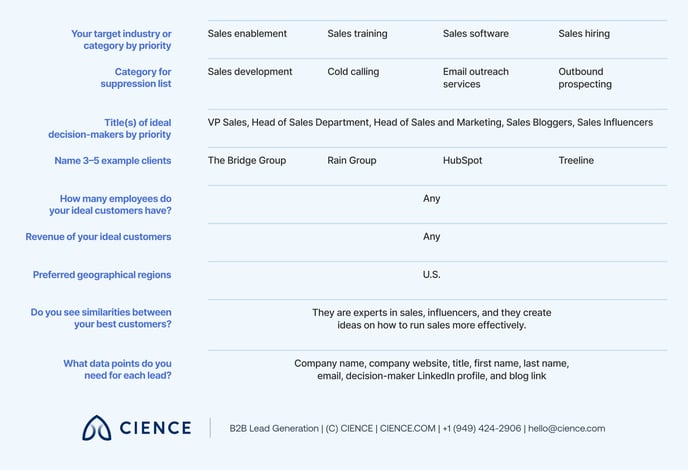
As you can see, we didn’t use the telephone number in the list of data points; we included a “Category for Suppression List,” which we use for particular companies that we don’t want to reach out to for several reasons.
We also included the question: “Do you see similarities between your best customers?” It’s the first step on the path to creating the specific requirements for potential leads. In this case, we wrote that we needed sales experts, influencers, and idea creators.
Ideal customer profile template
Here’s an ICP template that we ask our clients to fill out. Usually, our customers also provide detailed requirements to narrow down the search—something that no software can do. If you want to learn how to leverage the ICP or get your list of high-quality leads, don’t hesitate to contact us!
Sales perspectives on the ideal customer profile
The causal relationship between an ICP and sales research is obvious: The more detailed description of your ideal customer you provide, the more accurate leads you’ll get at the end of the day. We’ve seen it virtually in every campaign that we’ve implemented for hundreds of clients over the years.
However, what many people seemingly fail to understand is the impact of ICP on sales development. The ICP is about the regular analysis of your market and planning your sales strategy accordingly. If you don’t understand your market, you won’t know what to expect, and you won’t be able to plan. You can’t just fill in the ICP questionnaire based on guesses. This will only ensure your results are nothing but random.
The ideal customer profile influences the following aspects of your sales development activities:
- Number of leads: There’s a big difference between an ICP that covers the entire U.S. or the one that limits your sales research to several states (or even counties within a state).
- KPIs: The conversion, open, response, and appointment rates heavily depend on the industry and your target titles.
What Is a Buyer Persona?
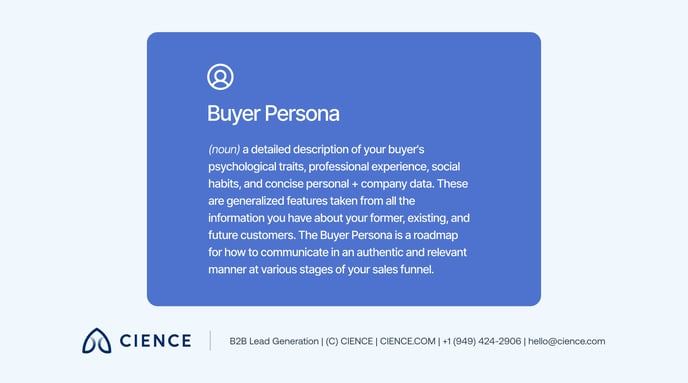
A buyer persona is a guide that helps your sales and marketing teams understand your potential buyers better and effectively engage with them at any sales stage. The BP should be based on a comprehensive analysis of all your customers, interviews with the sales team, and an audit of your sales pipeline.
The best buyer personas are always a combination of descriptive and prescriptive marketing analytics.
BPs always include a full name and a photo so that they can be treated as real individuals. This approach helps your staff feel closer to your real buyers and address their needs better. It’s vital to marketers who don’t always get to talk with customers face-to-face.
The BP profile is always presented as a set of generalized features relevant to the buying-selling process of your company. The term “generalized features” means that they have been observed in many, if not most, buyers. Meanwhile, “relevant” means that you need to look only for those traits that will help you understand the buying behavior of your potential customers.
Note: You don’t want to go too far in developing a BP. Only information correlated to the buying process should make the cut.
When creating your buyer persona, you need to think about the balance between the resources you’ll spend creating and the advantages certain information can bring.
Also, as a rule of thumb, it’s common to create several BPs based on different criteria: the type of service, size of company, industry, or the persona’s role in the company.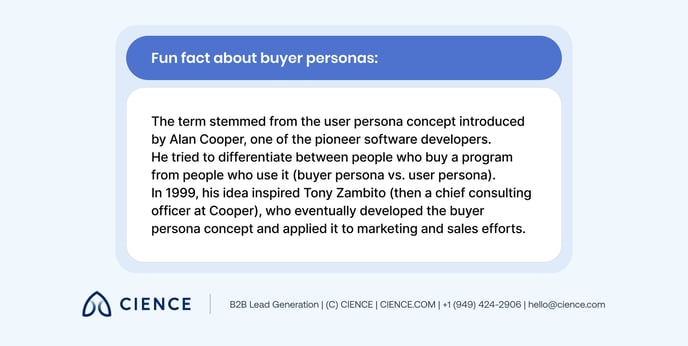
What are the key elements of a buyer persona?
Numerous articles suggest adding tons of information to describe a buyer persona. However, not all details are equally important in B2B.
According to Marcia Riefer Johnston, personal data of the lead (e.g., household income, family details, and pets) is less valuable than the professional background (e.g., years in marketing, degrees, and certificates).
The best practice in creating a buyer persona is to provide information about your customers that’s the most relevant for your selling process.
Let’s discover what elements you can include in a BP and their purpose:
1. Name and job title
- Persona name: Give your persona a name and specify their title. Stick to unisex names if you’re not creating separate buyer personas for males and females.
- Title: If you work predominantly with people who have an academic degree (Ph.D.) or medical doctors, consider using Ph.D. or MD after the name (e.g., Roan Kipling, Ph.D.)
2. Personality
- Psychological traits: Since the BP is not meant for counseling purposes, there’s no need to go too deep into the psychological analysis of your persona. Include the traits that make a person excel in their position or that people of particular roles usually exhibit.
For example, financial directors are usually highly analytic and lawyers attentive to details. This may not directly impact your prospecting but will help salespeople understand the psyche of the buyers. - Professional background: Include education, years in the position, certificates and courses, professional competencies, and possible weaknesses. You’ll need this information to craft your content based on the knowledge levels of your potential buyer.
For instance, if you offer your services to someone out of your industry, you might want to explain what you do in simple terms. It also helps to shape the sales pitch up to your clients’ needs.
Tip: Consider only a professional background related to the current job (find a job.) - Estimated awareness of your services: Use a 1 to 10 scale, where one is complete ignorance about your product, and ten is an expert level of knowledge.
This element, simple at the surface, isn’t the most obvious one. Like Sheldon from The Big Bang Theory, some companies fail to recognize that buyers may not know everything.
And that’s no wonder, is it? You’ve spent years doing what you do, and your leads just heard about you. If they knew all the things you do, they wouldn’t need you.
Tip: Make sure that your content educates instead of confusing the reader. - Sources of information: Where do your buyers learn new things related to their job? It may be from magazines, articles, influencers, books, events, etc.
Your sales team and content writers may use some of these sources to base the message to your potential buyer on the thoughts and ideas of people they trust. - Attitudes and beliefs: What do your buyers like/dislike about their jobs? Do they have any common prejudices toward certain practices associated with your service? Do they have conflicting attitudes toward certain professions?
For instance, it’s a common myth that outbound outreach is intrusive and therefore less effective. So, CIENCE, as an outbound call center, crafts our messages in a way that deals with this prejudice. Also, we have plenty of case studies and blogs that educate our audience on such issues. - Demographics: Include age or age group (millennials, generation Z, etc.) and gender. Besides those two, you may include any demographics essential in the buying process (religion, ethnicity, nationality, etc.).
For instance, working with foreign markets may require understanding the cultural or religious beliefs dominant in the region.
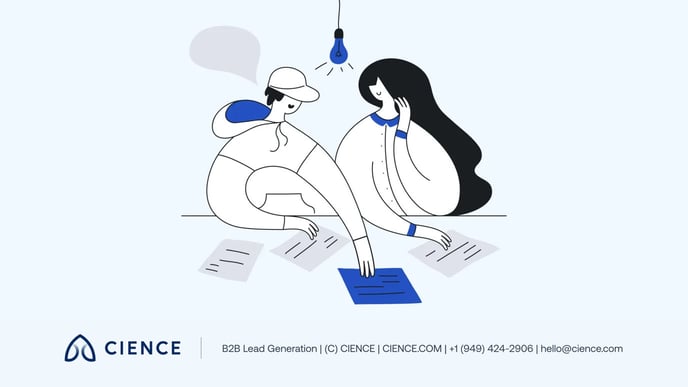
3. The working environment
- Firmographics: This entry should pretty much encompass your ICP’s company description that we’ve examined earlier. In addition to that, firmographics should also include industry specifics to help you understand your buyers’ KPIs, challenges, and goals better.
It will also help you to determine decision-makers and decision-influencers. - Goals, challenges, and KPIs: Here, you should list the primary KPIs your buyers track and differentiate the ones your services can enhance.
For example, the goal of the VP of sales is to bring new customers and improve the ROI. This KPI is relevant for us because we can improve their ROI.
Goals, challenges, and KPIs are what we call the “Bermuda Triangle” of your buyer persona: You’re the one who helps them sail safely through this sea into desired waters. - Sources of negative emotions: Pain points are important in prospecting because they become the groundwork for your value proposition. Ask yourself: “What do your potential clients fear most? What frustrates and disappoints them? How can your product help reduce these unpleasant emotions?”
Good insights into buyers’ frustrations will help you speak to the emotional part of the purchasing decision. - Job features: Think about the role you want to target, its predispositions, forecasting capabilities, need for a piece of certain information, or framing that defines their work (seasonality, weekly/daily pace, the frequency of business trips, events, etc.).
- Technology: If the tech stack they use is relevant to your services, you should state it in the buyer persona.
- Team: State the team’s size, strengths, and weaknesses: Who out of the team will use or benefit from your service? What problems do they face?
- The buying behavior
- Obstacles to solution acquisition: These are the real problems a buyer has during the buying process (low budget, lack of knowledge, a reluctance of top management, use of the product/service, your competitors, etc.). Think of criteria for potential obstacles and prepare ways to overcome them.
- Objections: Note that obstacles and objections are sometimes different things. Many objections are conditioned responses that come from a place of distraction, busyness, or disengagement.
Some objections are made to attain a specific goal (reduce costs or get a more profitable position in the negotiation process). They don’t describe the actual situation.
You should be able to provide clear reasons to overcome all of these objections. - FAQs: Create a reference doc for sales to use that includes common questions buyers ask about your services.
- Buyer journey: You should analyze the journey the leads take before becoming a customer: when they usually enter your funnel (inbound/outbound), if they ever go back to a stage, and how much time they spend at each stage.
- Decision criteria: Ask your existing and new clients what factor shaped their decision to purchase your services.
- Decision-making process: Determine how many people participate in the buying process and their roles (decision-makers, decision-influencer, gatekeeper, etc.).
- Post-purchase relationship: Continue to nurture the buyer, keep a close eye on your point of contact, expand or resell the account, or get a referral.
5. Summary
Summarize all of the data mentioned above into a short reference sheet for your sales team.
You are not obliged to use all of the elements we’ve listed; however, you should include those elements that can help your sales and marketing teams communicate with your potential customers better. Remember, you can and should revisit your buyer persona from time to time to make changes and improve it.
Should I create separate female and male buyer personas?
Honestly, it’s up to you. There are pros and cons to gender-specific BPs. The obvious advantage is that you may be able to provide a more personalized approach to your potential buyers.
The other less obvious advantage is that in the industries where there are fewer women in the C-suite, you can beat your competitors by simply tuning your sales and marketing to the female decision-maker. The disadvantage is that you’ll have to spend more time creating your BPs.
Here are some arguments that support both opinions, along with some suggestions on how to tackle this issue:
Gender in Business – Generation-wise Overview from CIENCE: Summing up the infographic, women’s presence in B2B buying as decision-makers is increasing. However, gender is perceived as a scale rather than two extremes by at least half of the millennials who embark on this process.
Women as B2B Buyers from CIENCE: We haven’t found any surveys that have proven the difference in behavior between baby boomer versus millennial females with a view of less strict gender differentiation perception observed in generation Y. This subject is yet to be studied.
Three tips for creating a female buyer persona:
- Use the Labor Force Statistics from the Current Population Survey by the United States Department of Labor to see the women’s representation in each type of profession; you can also look for the industrial statistics for female managers. There are plenty of organizations that keep track of this data.
- Ask your salespeople about the participation of women on buying teams and if, during the selling process, they’ve spotted any specifics about their communication/behavior mentioned in the survey above.
- Revisit your sales pipeline and analyze if you’re losing female buyers. To that end, check the percentage of women decision-makers in each team (as well as their influence). Then examine how female-driven groups pass from one stage to another. Is there a bottleneck? In this case, you should try creating a unique BP to address this issue.
For our own BP, we created and used the following questionnaire. You can download it and consider it as a base for your buyer persona template.
How many buyer personas are enough?
There’s not just one correct answer to this question since every company is unique. There are at least four factors that can influence your decision to create several buyer personas:
1. Decision-makers
The average number of people in the buying team now stands at 6.8. Not all of them are decision-makers (people who have the final word in the sale). The buying group also consists of approvers (to sign the contracts), decision-influencers (to provide an expert opinion), evaluators (to seek alternative solutions), gatekeepers, users (to use the product/service in the end), and more.
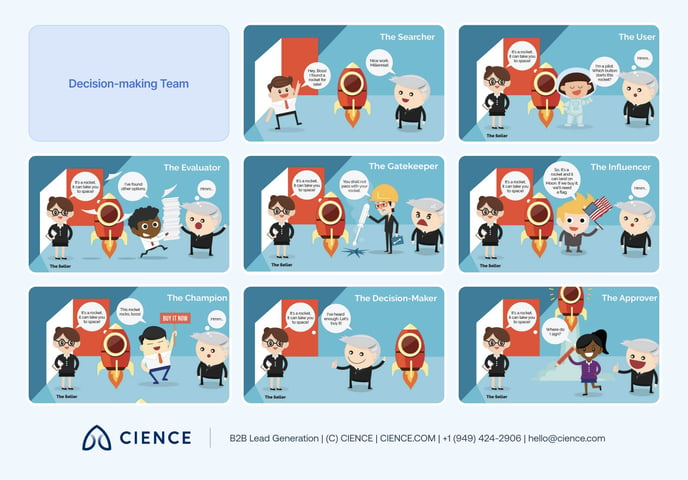
You don’t need to create buyer personas for each of these roles. The best advice is to pick those roles most critical to making a sale. However, you should analyze the average buying team and provide this valuable data in your BP.
2. KPIs, challenges, and goals triangle
The KPIs, challenges, and goals triangle is a core of your buyer persona because it’s what you’ll address when engaging each buyer using the content or in sales meetings. Every title in the company has certain performance criteria (KPIs) and problems that make it hard or impossible to achieve them (challenges). And they set many goals related to both KPIs and challenges.
Basically, your company provides a solution within this triangle. Though one product or service can address multiple challenges and help achieve various goals of different titles in the company, the messages will be different.
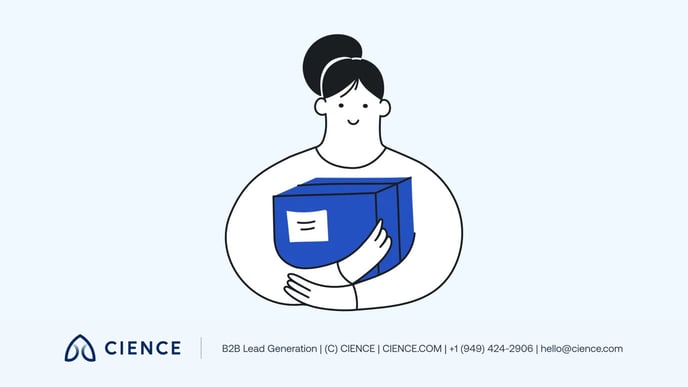
3. Buying psychology
Behavioral features for your buyers may include attitudes, expectations, emotions, and beliefs. For instance, some people tend to think about future positive outcomes while others mostly have concerns about the negative implications:
- Psychological traits: This includes extraversion scale, ambiguity tolerance, risk aversion, openness to new experience, and ways of processing data.
- Behavior during the buying process: Depending on our attitudes, traits, beliefs, and emotions, we act differently.
If you’ve spotted different buying psychologies related to certain roles, you can create separate buyer personas. The RAIN Group has summarized six different behavioral patterns during negotiations and provided valuable insights on approaching them.
4. Primary searcher
Not all decision-makers will search for a solution to their problems themselves: There’s often an executive assistant or simply a person on the team who’s in charge of creating a list of vendors. You’ll want to get on that list for sure.
You don’t need to create a separate buyer persona for the searcher. But when planning your sales engagement, you need to keep them in mind because they may be your gatekeeper.
7 Steps to Creating the Buyer Persona and Ideal Customer Profile
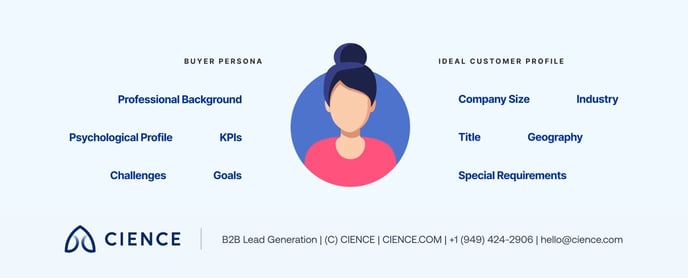
We suggest creating ICP and BP at the same time. You’ll need your marketing and sales teams to work together and follow these steps to get the best results:
1. Analyze current opportunities.
Analyze your current and former customers according to the following criteria: revenue, number of employees, industry, region, product, and customer lifetime value (CLV). Create a final table with these criteria:
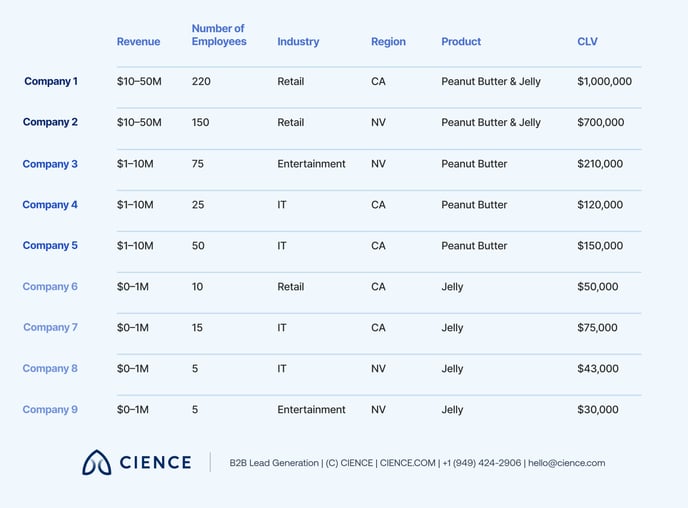
In this simplified table, you can see that retail companies prefer peanut butter and jelly. Meanwhile, companies with $1–10M in revenues don’t buy jelly, the product favored by $0–1M organizations. You can observe that your main clients come from two states, Nevada and California. And your major industries are retail, entertainment, and IT.
You might as well add some specifications to this table. For example, IT is a big industry. Do these companies create software or provide internet? What is the purpose of the purchase? Do they offer peanut butter to their specific clients as a bonus, or do they use it themselves? Do they use it with some particular type of bread? Do they purchase jelly somewhere else, or do they simply not like it?
For a more extensive set of data, you can create all types of analytics. Your goal here is to find out what types of customers are the most profitable for you. The data from the above table doesn’t give you, however, the complete picture.
2. Check for lost opportunities.
Are you sure that you work with all the industries and company sizes that might need your product? Can you possibly expand to other regions? What if you miss something important? That’s why you need a comprehensive analysis of the conversions along your sales pipeline. Take a look at this example:
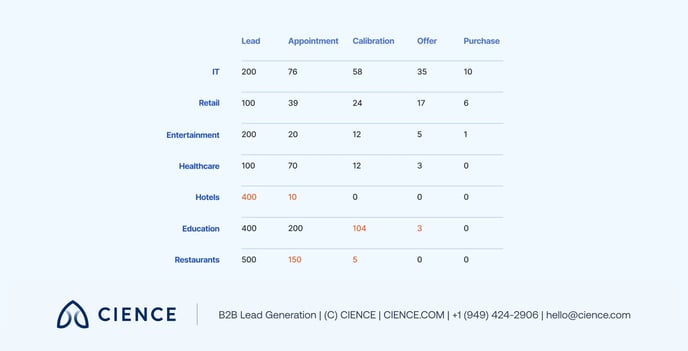
As you can see, at some point, there’s a bottleneck that prevents companies from certain industries from advancing in the sales pipeline. Why don’t educational establishments order your peanut butter and jelly? They’ve got tons of hungry kids and teenagers who enjoy PB&J sandwiches. The same is true for hotels and hospitals.
Don’t hesitate to address the lost customers and interview them about their sales process and why they opted not to work with you. You might find out that your product is a bad fit for them or otherwise learn what your sales managers did wrong during the negotiation process.
3. Implement sales intelligence.
Look at your customers’ competitors and analyze them by industries, size, and geography. Obviously, you won’t get a full scope of their clientele. However, a simple look at the client section of their websites might get you a valuable hint of where to look for clients. Be aware that you may not implement everything your competitors do, so you’ll need to analyze how they managed to win these types of customers.
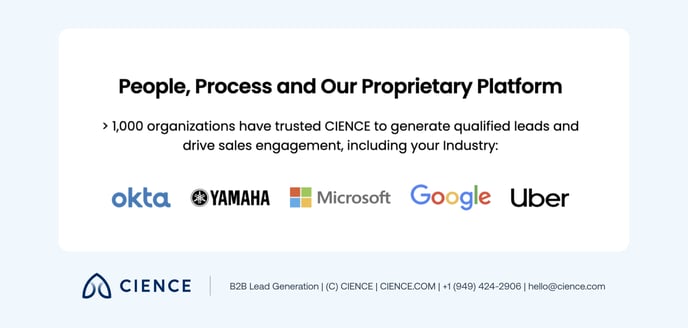
Based on the information above, you can also use machine learning algorithms to identify trends from closed, won, or lost account data and offer everything from lead scoring (likelihood to close) to lookalike companies to target moving forward.
An efficient way to study the new industry or company size is with targeted outreach via email and phone calls. You’ll learn what competitor services they use, and you’ll be able to gain valuable insights by simply asking questions about the problems these organizations are experiencing.
4. Define decision-makers.
Once you’ve defined the companies you want to target, you need to understand what titles will be the actual decision-makers in these organizations. Consider these two approaches:
1. Product-solves-problem approach
New products and services that come out are meant to solve problems. This way, the progress and competition between companies continue. What problems does your product or service solve? What departments within an organization have them? And finally, what titles run these departments?
Let’s use the services CIENCE offers as an example. Our SDR team finds accurate contact data following an ICP and then conducts a personalized outreach to these prospects via email, phone, and social networking websites. We use our service for our internal purposes.
By analyzing how we use our product, we can outline three important decision-makers: head of sales, director of marketing, and CEO/founder/owner.
2. Customer-oriented approach
Your experience using your services may not give you the complete picture, though. For instance, some of your customers might come from very different types of departments—much to your surprise. That’s why you need to conduct a survey both among your buyers and your salespeople.
Analyze the titles in the average buying team. Don’t forget to specify the company parameters you’ve outlined before—there might be a certain pattern. For example, the average buying team for SMEs might be very different from the one at a giant enterprise. You don’t want to target the wrong people in the company.
Ask your sales team to indicate which decision-makers have the most influence on a purchase. In companies of different sizes, the same roles will have a different impact.
Pick a few roles that have the most influence. Outline different names that the same position might have in various companies.
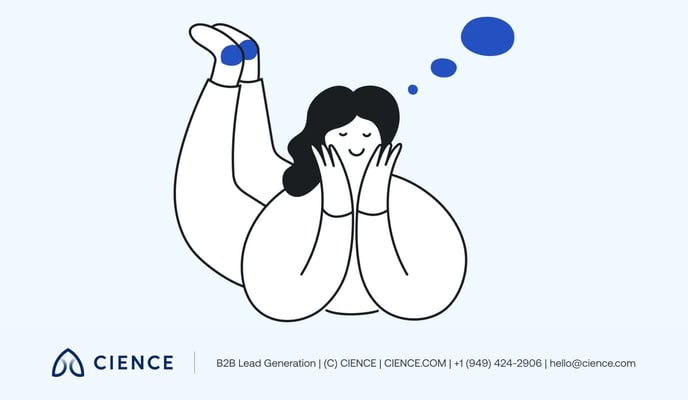
5. Summarize the ideal customer profile.
Set the list of data points (contact data entries) you’ll need to search. This list includes, but isn’t limited to: website, phone number, address, name, title, social media profiles, and any additional data that you find relevant to your business (see the “special requirements” section).
6. Compile the data.
At this step, we start our BP construction. Survey your sales team, the titles of the buying team of your clients (including former ones), current prospects, and lost opportunities (the last will save you from survival bias). Pick the parameters you consider the most valuable in the buyer persona template and outline the questions you’ll need to ask your interviewees.
Learn how to interview clients to create a perfect ICP.
We suggest omitting questions about the title, firmographics, professional background, and demographical data because it’s the information you can easily find on LinkedIn or corporate websites. Don’t ask your buyers about their psychological traits, typical objections, or prejudices (leave these questions to your sales).
Tip: Make the survey about your lost opportunities as short and easy as possible. Use checkboxes and list boxes. Explain that you want to understand the reasons why your company didn’t fit them: Was it the product, terms, salespeople, or something else? Don’t forget to express your gratitude for considering your company and services.
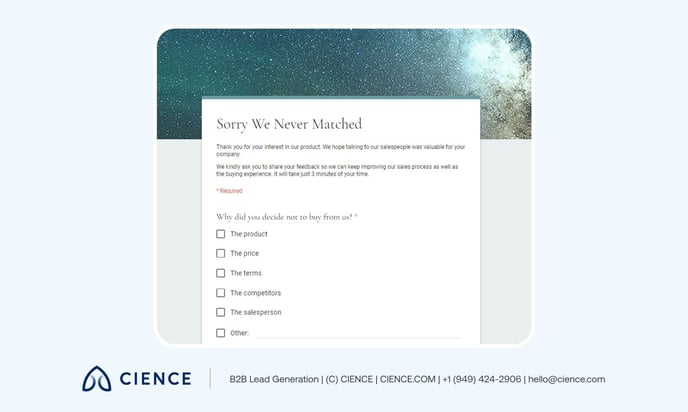
The survey of the organizations that are currently in your pipeline shouldn’t be too long either. Explain that the goal of this survey is to provide the best buying experience to all of your customers.
If you wonder how many people you should question about these things, we’d say, the more, the merrier. The bigger the number of researched people, the more accurate and credible the results will be. However, make sure to only question one or two people at one company to avoid spam.
Consider one more source of information—the records of the sales calls and meetings (we use and recommend both Chorus and Gong). You might learn a lot from them. At the beginning of a negotiation, good salespeople mostly ask questions about the problems of potential customers and then listen. Use this information to shape your buyer persona.
7. Make final revisions.
Building meaningful communication is one of the primary purposes of both the ideal customer profile and buyer persona. To make sure the information you’ve included in these two documents helps to create connections with your potential buyers, you have to revise everything and ask yourself a few questions.:
- Does this element help us?
- What messages should our marketing and sales team convey to our potential customers to leverage this feature or minimize this obstacle?
- How can we help our potential client advance to the next sales funnel stage and eventually make a purchase?
Once your sales and marketing people agree upon the ways to communicate with prospects, write them down and finalize your buyer persona.
Afterward, give it to your sales team for their approval. If the BP reminds them of your customers, then you’ve succeeded. If not, listen to their feedback and improve.
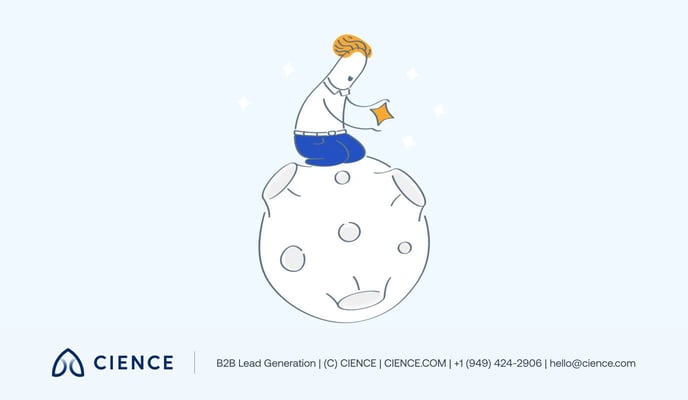
What Happens Next?
Next comes the most exciting part—applying your buyer persona and ideal customer profile in your sales and content marketing. You’ll use ICP at the beginning of the lead generation process and the BP throughout every stage of the sales funnel journey.
Like everything in lead generation, creating a buyer persona and ideal customer profile takes time and effort. Nonetheless, we strongly recommend investing in this process, and as a reward, you’ll get a smoother sales cycle and happier customers.
Editor’s note: This post was originally published in Nov. 2018 and has been completely updated for accuracy and comprehensiveness.
A Few (Related) Sales Posts
 Featured image: The Ultimate Cold Calling Guide: Proven Tips & Techniques - Read full post: The Ultimate Cold Calling Guide: Proven Tips & Techniques
Featured image: The Ultimate Cold Calling Guide: Proven Tips & Techniques - Read full post: The Ultimate Cold Calling Guide: Proven Tips & Techniques
The Ultimate Cold Calling Guide: Proven Tips & Techniques
 Read full post: How to Generate High-Quality B2B Sales Leads
Read full post: How to Generate High-Quality B2B Sales Leads
How to Generate High-Quality B2B Sales Leads
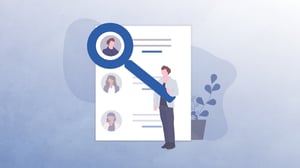 Read full post: Targeted Lead Generation Guide: 4 Steps and 6 Tips to Get the Right Leads
Read full post: Targeted Lead Generation Guide: 4 Steps and 6 Tips to Get the Right Leads
